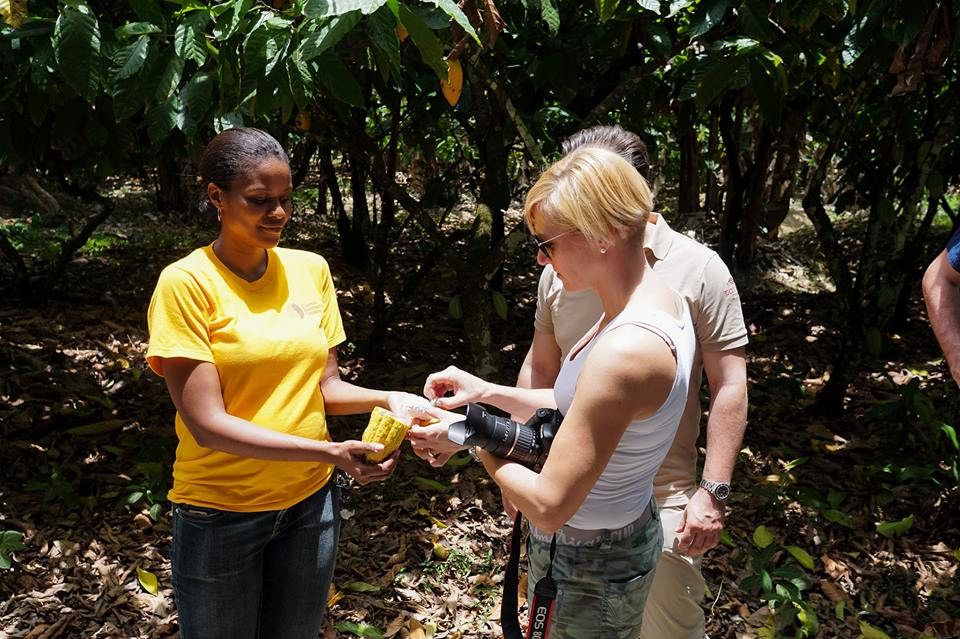Genebank Tour
Imagine a nature lover’s paradise created by lush cocoa trees, majestic Immortelle shade trees, the watercourses to irrigate fields, idyllic reservoirs, together with wildlife that includes many species of birds, squirrels, and (a few) snakes.
It’s a place where one can relax and enjoy nature while learning about the cocoa industry, the history of chocolate; and the importance of conserving biodiversity (particularly that of cocoa) and our environment. Welcome to the ICGT: the International Cocoa Genebank,Trinidad!
The ICGT tour offers a unique opportunity to observe the widest variety of cocoa (Theobroma cacao) trees to be found anywhere in the world apart from where it was collected at the centre of origin of cocoa in South America. It is a treasury of cocoa genes spanning an area of 37 hectares.
The ICGT tour encompasses a scenic route through one (or more) of six cacao fields, varying in size from 1.3 ha to 6.2 ha, and ends with a taste of local cocoa “tea” and dark chocolate. Educational literature will be made available on demand. In future, there will also be opportunities to purchase branded products (“T” shirts, caps, cloth bags etc.), and documentaries of cocoa on CD.
Download the tour brochure : Genebank tours.


Tour Guidelines
What To Wear: Enclosed shoes, (sneakers or boots preferred), long trousers (jeans or thick cotton material), long sleeved shirt, mosquito repellant.
Cost (Non locals): $60 USD per person (includes round trip transportation from The UWI to the ICGT). Minimum # of participants: 4 (If you wish to request a tour but do not have 4 people, please inquire and we will try to facilitate you if possible)
Cost (Locals): Tour package 1: Two to Five Persons: $500 TT (No transport included)
Tour package 2: Six to Ten Persons: $600 TT (No transport included)
Tour package 3: Eleven to Fifteen Persons: $900 TT (No transport included)
Special discounts are also available for school groups
Bookings must be made at least three weeks in advance to ensure availability. Please complete the online booking form. You will be contacted to confirm the booking.
The tour should take 1 to 2 hours and there will be opportunities for guests to explore as they proceed along the tour route however unsupervised exploration of the ICGT fields is prohibited for safety reasons.
More details on the ICGT
The ICGT was originally part of the La Chaguaramas Estate at Centeno, and is situated at the University Cocoa Research Station, approximately 5 km from Piarco International Airport.
Bordering the ICGT are the Caroni River (North), the fields of the La Reunion Estate, which belongs to the Ministry of Food Production, Land and Marine Affairs (East and West) and the abandoned sugar-cane fields of the former state company, Caroni 1975 Ltd (South)..
Currently, approximately 2,200 types/accessions (represented by about 12,000 trees) are conserved at the ICGT and additional clones are added as they become available. These trees represent all the major recognised cocoa groups (Forastero, Criollo, Trinitario and Refractario). They include the famous Trinitario clones, the Imperial College Selections, which originated and have been cultivated in Trinidad & Tobago for many years and are responsible for the enduring and fine reputation of Trinidad & Tobago cocoa. There are also related species of Theobroma such as T. speciosa and microcarpa.
The majority of cocoa types or accessions are from the late Dr. F.J. Pound's germplasm selection activities in Trinidad & Tobago and his expeditions to the Upper Amazon, and others are from numerous other subsequent collecting expeditions to obtain genetically distinct material in South and Central America. Acquisitions since 1990 are (Trinitarios) from other islands in the Caribbean and Central America, material from French Guiana and Venezuela, wild Criollo material from Belize, and genetically diverse Upper Amazon clones from Ecuador. Field 7 contains the valuable results of CRC’s germplasm improvement efforts.
The trees are established in a square planting design and the majestic Mountain Immortelle and the River Immortelle (Erythrina sp.) provide permanent shade while non-commercial bananas provide temporary shade. In order to secure water for the genebank in a sustainable manner, two reservoirs were built in the ICGT and permanent (subterranean) irrigation pipes were installed.
For further details, please call CRC office at 662-8788 or send us an email. Tours must be booked at least three weeks in advance to allow staff to prepare.







